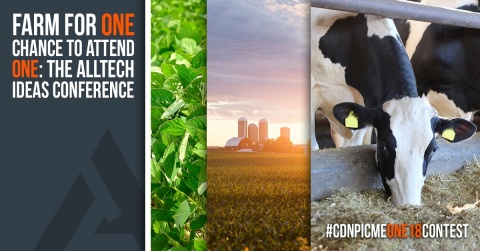“Having me on staff, a registered dietitian, working at an animal nutrition and crop science company is really unheard of.”

In one sentence, nutrition specialist Nikki Putnam spoke volumes about what distinguishes Alltech in the world of agriculture.
Yes, it’s an animal nutrition and crop science company, but it’s actually much more. And the reason for that is the three-decade guidance of its ACE principle: Alltech’s belief that new technologies and their adoption throughout the food chain will contribute to a more sustainable world. The principle mandates that any such technologies “must improve the health and welfare of Animals, satisfy Consumer demands and protect the Environment.”
This installment of our ACE series highlights Alltech’s quest to address the rise of the socially conscious consumer and their demand for healthy, safe and sustainably produced food.
Following through to the end of the food chain
We begin at the end. The end of the food chain, that is, and Putnam’s dot-connecting role at Alltech.
“It’s very rare in this industry to have someone who is solely focused on human nutrition helping to bridge the gap between what we’re doing in crop science research and production, what we’re doing with animal nutrition and animal science, and bringing that around to ‘How is this applicable to human health, nutrition and increasing well-being?’” said Putnam.
Accommodating the expectations of an evolving consumer culture presents its challenges.
“That culture has been changing a lot in the last five years, and we’re well-adapted to address it because we can say, ‘This is an organic product that is traceable through an organic production system. This is a product that is non-GMO; this is an antibiotic-free product,’” said Dr. Karl Dawson, vice president and chief scientific officer at Alltech.
“These types of products are arriving on grocery shelves now and in the restaurant,” he said. “Even fast food chains are using these terms. We try to build our sales and research programs around that.”
In fact, Alltech has partnered with the leading third-party audit for Whole Foods, Where Food Comes From, to become the flagship company for their Feed Verified program. This verification is important to Alltech because it provides clear, traceable assurance for claims, such as antibiotic-free, so consumers can trust and understand how their food was raised.
Listening to the consumer
Dr. Steven Borst, general manager of Alltech’s crop science division, would have enough on his plate focusing on the myriad issues associated with growing plants, but he also keeps in mind the needs and desires of the ultimate consumers of crops: humans.

“Consumers want to know that what they’re picking up in the supermarket is completely safe, is being grown in a manner that would be sustainable,” he said. “Consumers are demanding more accountability and more and more traceability. We’ve helped strengthen the ability for the consumer to know that.”
Alltech Crop Science is focused on providing natural inputs as viable alternatives to the synthetic chemicals that inspire consumer concerns and resistance.
“We’re improving our soil, increasing the nutrient availability by allowing the plant to uptake more nutrients,” said Dr. Kyle McKinney, Alltech Crop Science development manager for Central America and the Caribbean.
Agriculture is undergoing a mindset change
Borst finds farmers and producers increasingly sensitive to how their products are received in the marketplace. They are gravitating to a new, more expansive way of thinking.
“The mindset that says, ‘I need to spray X to kill Y in order to achieve excess yields,’ that silver bullet mentality has completely shifted,” he said. “Farmers are looking not just at boosting yields, but for ways to mitigate, say, a weed problem, and how does that impact the entire holistic system? That’s a major shift that we’ve started to see. It’s driven by farmers wanting to take better care of their land and come up with alternative ways to maximize profits, as well as the potential of their croplands and systems.”
No one, Borst said, cares more about the land and the environment than the farmer.
“There’s no more of a scientist than a farmer,” he explained. “We’re seeing continual management program and thought-process changes. That’s a relatively new phenomenon that’s occurred over the past 10 years. I would argue that when we started Alltech Crop Science, we were 30 years ahead of the curve in regard to this mentality. Now it’s starting to catch up.”
Banana growers are listening
Banana production in Costa Rica offers a clear example of how Alltech technology is replacing unsustainable practices.
The banana plantations of Costa Rica have been plagued by black sigatoka, also known as “black leaf streak,” a disease spread by the fungus Mycosphaerella fijiensis. For plantation owners, battling this disease has been a choice between frequent application of chemical fungicides or losing their crops.

“Producers want to reduce this (dependency on chemicals),” said McKinney, who is currently stationed in Costa Rica, working on solutions. “Consumers are demanding it and buyers are demanding it, so they’re looking for alternatives.”
The focus of McKinney’s current work is on two products from the Alltech Crop Science portfolio: Soil-Set® and Agro-Mos®.
Trials of the products transitioned early this year to commercial application.

“Starting in January of 2017, we went from zero hectares to over 3,000 hectares in one month,” said McKinney. “Producers saw and believed in the results and took the steps to reduce their chemical usage because here’s something that allows them to do it naturally, and they can feel good about it.”
Going to the source of a dietary imbalance
Consuming omega-3 fatty acids, mostly by eating fish, is associated with the prevention or reduction in severity of a multitude of ailments, from heart and kidney diseases and diabetes to Alzheimer’s disease and osteoarthritis, according to the National Center for Biotechnology Information (NCBI).
But in the Western world in particular, consumption of foods that deliver adequate levels of omega-3 is woefully low.
Human beings evolved on a diet with a ratio of omega-6/omega-3 essential fatty acids of approximately 1:1. But, in Western diets, the ratio is 15:1, according to the NCBI.
Numerous diseases are linked to this imbalance and a resulting serious deficiency of DHA, a compound contained in omega-3 fatty acids that, while essential to human health, is not produced by vertebrates.
“We’re trying to increase the amount of omega-3s that consumers are eating because when that ratio is out of whack, we see a lot of inflammation in the body,” said Putnam. "Inflammation is the root cause of all chronic disease — heart disease, diabetes, Alzheimer’s, arthritis, etc.”
But, there’s a catch.
Omega-3 historically has been obtained from fish oil. Increasing demand, however, has pushed the world’s fisheries to or beyond capacity, with many of these ecosystems at risk of collapse.
The alternative to overfishing in the ocean is aquaculture. The fish farming industry’s own demand for fish oil and meal to feed its stocks, however, has only added to the pressure on ocean fisheries.
Alltech researchers have found a solution in Aurantiochytrium limacinum, one among the tens of thousands of named species of algae.
“We’re growing our own algae — the same algae that those fatty fish are consuming through their diets in the ocean,” said Putnam. “That’s what gives them their DHA and total omega-3 content in their tissues.
“So, instead of relying on those fatty fish in the ocean to provide us that fish oil or those omega-3 fatty acids, we’re growing that same strain ourselves,” she continued. “That way we can preserve the fish for protein sources and use our algae as the omega-3 or DHA source in aquaculture and livestock diets.”

These algal-based products are being produced at the Alltech Algae plant in Winchester, Kentucky, USA, one of the largest commercial algae production sites in the world.
Dr. Sasha Tozzi, the facility’s technical manager, said studies have found that balancing the omega-6/omega-3 ratio is associated with decreased mortality and prevention of cardiovascular diseases, certain types of cancer and inflammation among rheumatoid arthritis sufferers.
The benefits of the balance don’t stop there.
“It’s good for pregnant women and the early development of children to have a high-DHA diet because what mommy eats is what the baby eats,” said Tozzi. “You improve hand-eye coordination, visual acuity, motor skills, attention spans, verbal and social skills. And there are a lot of studies that show how different concentrations of intake of DHA at different ages really improves cognitive ability and behavior in children.”
Alltech’s growing portfolio of algae-derived products and applications are being marketed worldwide. The products are currently undergoing U.S. Food and Drug Administration registration and trials required for sales in the United States.
Reducing antibiotics in the food chain
The use of antibiotics in livestock has become a hot-button issue for consumers concerned about the effects to human health as well as the evolution of antibiotic-resistant bacteria.
“Consumers are looking for alternatives,” noted Dr. Kristen Brennan, a research project manager at the Alltech Center for Animal Nutrigenomics and Applied Animal Nutrition in Nicholasville, Kentucky. “Some don’t want antibiotics to have been given to the animal proteins they buy. With our work, we can provide not just alternatives to antibiotics, but more viable alternatives.”
And, in a nod to the ACE principle, the goal has been to develop solutions that are beneficial to the animal, the producer and the consumer, said Brennan.
Simply eliminating antibiotics from production animals will not in and of itself solve the problem of antimicrobial resistance.
“We have created the problem over the past 70 years, and we can’t expect to resolve it overnight,” said Dawson. “We must turn the tables and address eliminating antibiotic resistance from the environment.”
In Dawson’s view, that means being forward-thinking by developing and implementing practices that keep production animals healthy, which reduces a need for antibiotics. This can be as basic as improved farm hygiene and more biosecure animal housing, bearing in mind that even the cleanest operations can still experience disease.
Strategic nutritional management programs are an important component as well. Among the alternatives to antibiotics are direct-fed microbials, prebiotics and plant extracts. Alltech is ahead of the curve, having pioneered antibiotic-free technologies since the company was founded in 1980. This has led to new innovations backed by 733 published trials, resulting in multiple developments in the area of antibiotic-free production.
The Alltech® Antibiotic-Free program starts by supporting the animal’s immune and digestive system and allows for periods of adjustment. As the producer advances to the next level, the program helps provide a gut health management approach. This includes seeding the gut with favorable gut microflora, feeding the beneficial bacteria and maintaining a proper intestinal environment, and weeding out unfavorable microorganisms to support immune defense.
The next step is the full Alltech Antibiotic-Free program, which provides a complete approach to animal well-being, including management, nutrition and technical support. The program supports animals with maximum health benefits through Alltech’s full range of technologies, allowing them to reach their genetic potential and helping producers to attain a sustainable and profitable future.
“Our goal is to make sure producers have the right tools and resources necessary to make this transition as safely and profitably as possible while still getting the consumer the quality product they want for themselves and their families,” said Aidan Connolly, Alltech vice president and chief innovation officer.
Environmentally friendly livestock
Today’s consumers also express worries about the environmental impacts of livestock.
“We look at the efficiency with which these animals produce food for humans,” said Alltech research project manager Dr. Amanda Gehman. “If we can have an efficient animal, that animal is by nature a more environmentally sustainable animal.”
Dawson agrees.
“The environmental impact follows,” he noted. “If you are putting less feed into an animal and having less waste material, then you’re talking about an immediate environmental impact, whether that’s the manure that is spread on the land or the methane that escapes from the cow or the pig.”
This attention to sustainability in livestock production matters not only to grocery store shoppers, but also to many restaurant executive chefs, including Jonathan Searle of the Louisville, Kentucky-based boutique hotel chain 21C Museum Hotels.
“Along with looking for the highest quality locally sourced beef, we’re actively looking for a provider that is environmentally aware and taking steps to lower their carbon footprint,” he said.
Alltech has harnessed the innovative power of biotechnology to offer a variety of solutions to many of the farm-level issues becoming of interest to consumers. Examples include:
- Alltech E-CO2 provides environmental assessment services to livestock producers, enabling them to closely monitor the carbon footprints of their operations.
- Optigen® is Alltech's non-protein nitrogen source for ruminants. It concentrates the nitrogen fraction of the diet, creating dry matter space for more fiber and energy. Optigen has become a solution to feed and environmental problems.
- Allzyme® SSF is based on an ancient process called solid state fermentation (SSF). A selected strain of (non-GMO) is used to work in synergy with the animal’s digestive system in breaking down layers of the feed that were previously inaccessible through digestion. With the increasing global population and need for food, it is essential that producers get optimal performance from their animals and their diets.
- Alltech® In Vitro Fermentation Model (IFM) is a diagnostic tool that simulates rumen fermentation and evaluates the nutritive value of total mixed rations in terms of digestibility and end-products formation. IFM can help nutritionists determine if protein supply may be limiting microbial protein production and help make recommendations to address that issue. In addition, IFM researchers can identify opportunities in the ration to take advantage of reformulation.
- Total Replacement Technology™ provides organic forms of trace minerals (zinc, copper, manganese and selenium) that are more bioavailable to the animal, reducing waste and heavy metal pollution.
- The BioBarrel®, an edible feed supplement container manufactured by Alltech’s Ridley Block Operations, is providing producers with an effective land management tool that can be used to regulate the movement of herds and prevent overgrazing.
- KEENAN, the Alltech-owned manufacturer of diet feeders, is increasing farm efficiency by producing an advanced optimal physical mix of feed that improves yield, quality and returns. The company’s InTouch service provides producers with live support from skilled nutritionists who offer key advice for better data-driven decision-making.
- Yea-Sacc® is a yeast culture based on a proprietary strain of Saccharomyces cerevisiae, a yeast strain specifically selected for its influence on animal performance. Yea-Sacc helps stabilize the rumen environment for improved feed efficiency and is ideal for beef, dairy, calf and equine feeds.
Helping producers ACE the consumer connection
Today’s farmers are looking for technologies and products that help them provide consumers with quality meats, eggs, milk, fruit and vegetables, as well as information about the origins of foods and how it was produced.
Alltech, with a corporate culture that considers the entire food chain, from seed to steak and salad, is enabling the integration of innovative technologies with on-farm practices.
In our fourth and final installment, we will take a look at how ACE has evolved since its inception some 30 years ago and how it might be expected to carry the company and its customers forward into the future.
Take a look back at our ACE-ing sustainability series
“A” is for animal
“E” is for the environment






















